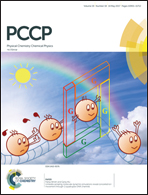Structure and dynamics of [NH2(CH3)2]3Sb2Cl9 by means of 1H NMR relaxometry – quadrupolar relaxation enhancement effects
Abstract
1H spin–lattice relaxation experiments have been performed for [NH2(CH3)2]3Sb2Cl9 (tris(dimethylammonium)nonachlorodiantimonate(III)) in the temperature range of 253–313 K and a broad range of frequencies – from 4 kHz to 40 MHz. From the analysis of quadrupolar relaxation enhancement effects (quadrupolar peaks) associated with 14N nuclei, two lattice sites characterized by different electric field gradient tensors have been revealed. The 14N quadrupolar couplings and asymmetry parameters at these sites differ by a factor of about two. Three motional processes have been identified and attributed to the overall dynamics of the NH2(CH3)2 cations (slow motion), dynamics of the NH2 groups (intermediate motion) and methyl group rotation (fast motion). It has been shown that the slow dynamics is only weakly temperature dependent, while the intermediate and fast motional processes are characterized by activation energies of 2.92 kJ mol−1 and 0.41 kJ mol−1, respectively. The correlation time of the slow dynamics is of the order of μs, while the intermediate dynamics is faster by 2–3 orders of magnitude (depending on temperature). All correlation times have turned out to be independent of the position of the cations in the lattice (they are the same for both lattice sites). The analysis presented in this work is an example of the potential of the quadrupolar relaxation enhancement effects as a method revealing information on the dynamics and structure of solids.
![Graphical abstract: Structure and dynamics of [NH2(CH3)2]3Sb2Cl9 by means of 1H NMR relaxometry – quadrupolar relaxation enhancement effects](/en/Image/Get?imageInfo.ImageType=GA&imageInfo.ImageIdentifier.ManuscriptID=C7CP00788D&imageInfo.ImageIdentifier.Year=2017)


 Please wait while we load your content...
Please wait while we load your content...